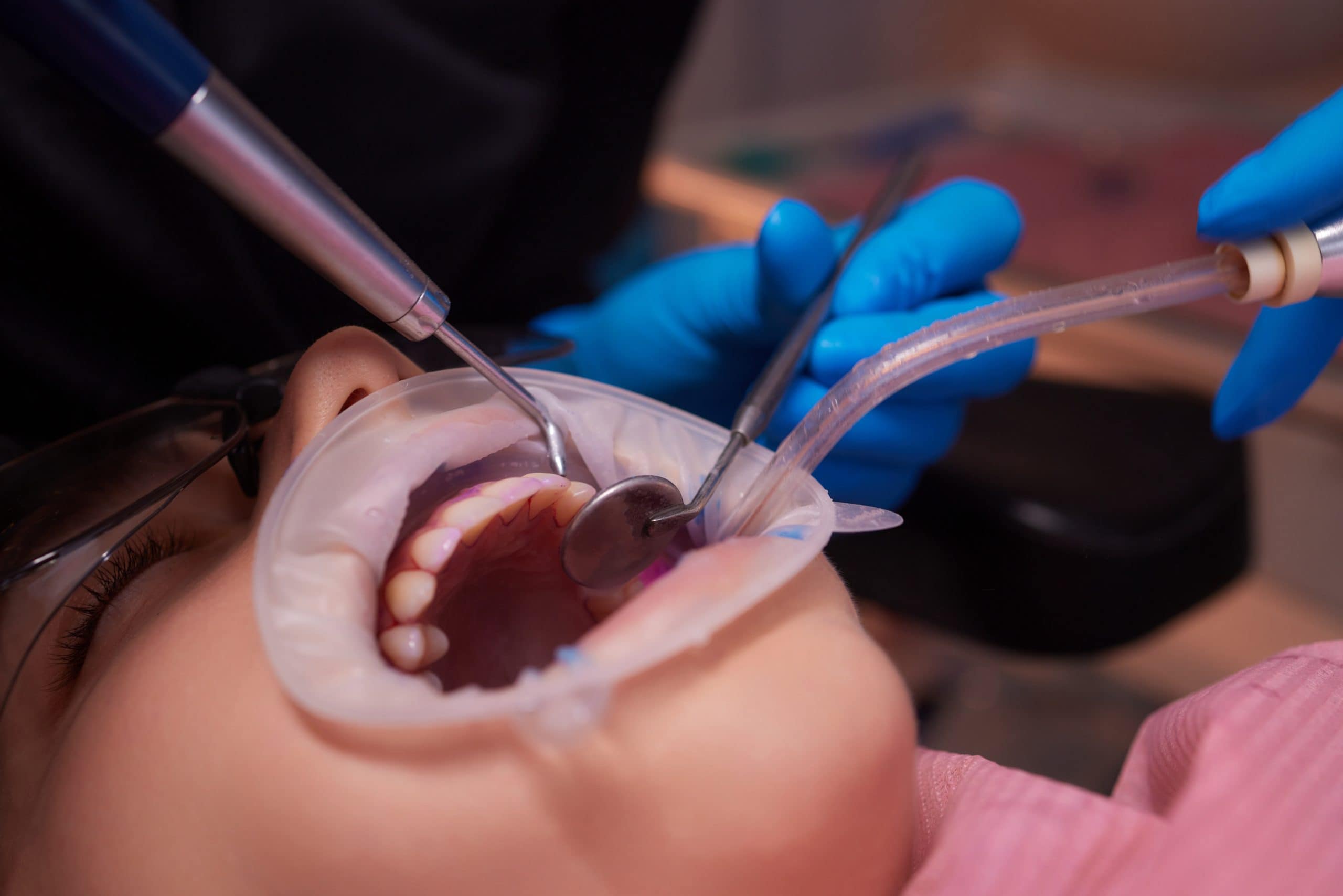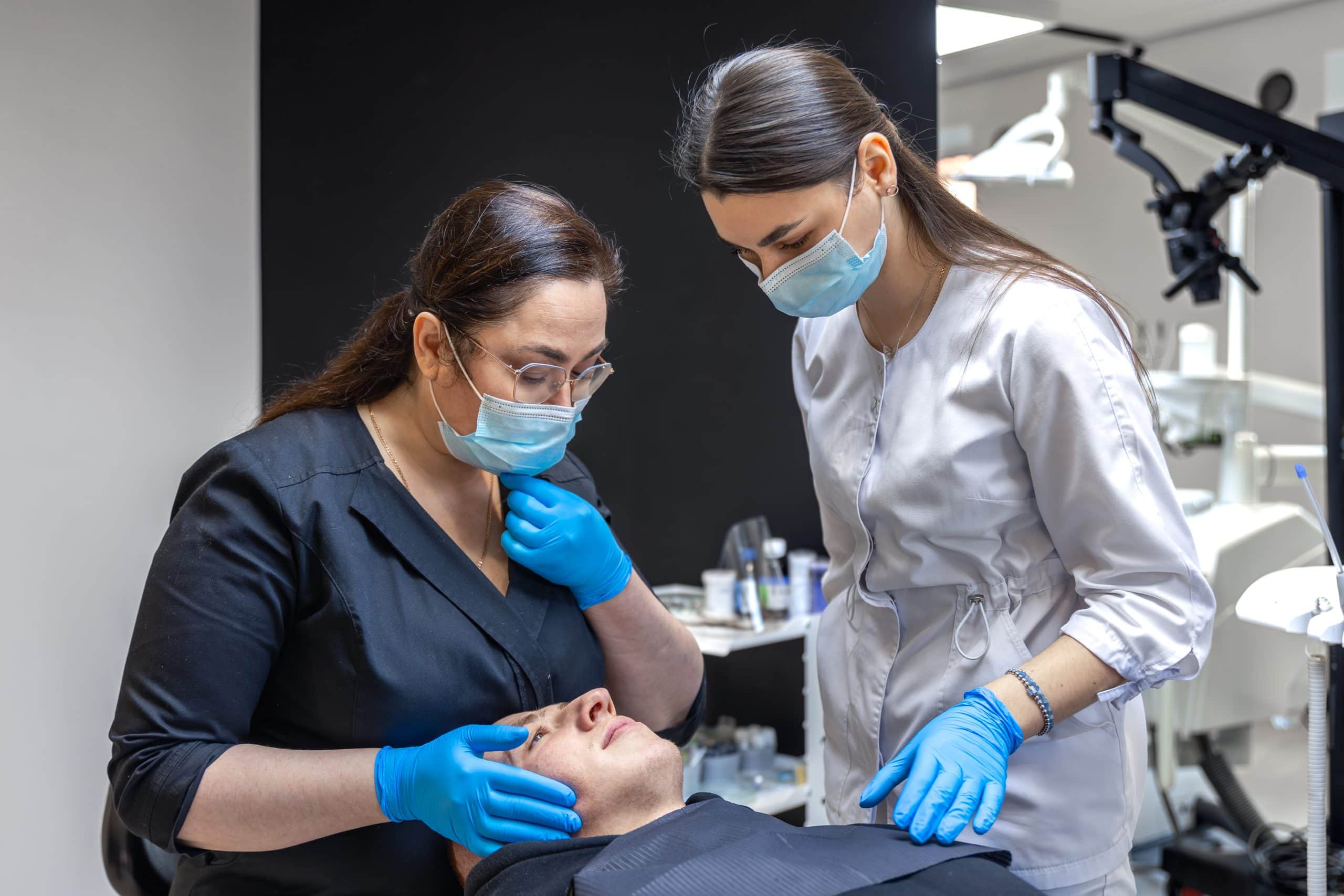Tooth decay is a common reason people undergo root canal therapy, but it’s not the only one. In some situations, a root canal treatment without a cavity becomes necessary when the dental pulp, the soft tissue inside the tooth, becomes inflamed, infected, or damaged.
Trauma to a tooth, deep cracks, repeated procedures, or large restorations can all affect the pulp, even when the tooth surface appears healthy. When this tissue is compromised, symptoms such as pain, prolonged sensitivity, or swelling may develop, prompting the need for further care.
If you’re experiencing persistent tooth discomfort, it’s important to consult a dentist who can conduct a detailed assessment. They can advise if root canal treatment may be appropriate, even in the absence of visible decay.
- Root canal treatment is not limited to tooth decay—it also addresses issues such as trauma, cracks, and pulp damage resulting from dental procedures.
- Pulp damage can occur without visible cavities and may result from injury, repeated treatment, or faulty restorations.
- Common symptoms of pulp damage include persistent pain, temperature sensitivity, tooth discolouration, and swelling or tenderness.
- Diagnosis involves tests such as thermal and electric pulp testing, percussion, palpation, and imaging techniques, including X-rays and CBCT.
- Root canal treatment includes removing damaged pulp, cleaning the canals, and sealing the space to preserve the natural tooth.
- Recovery after root canal treatment typically involves mild discomfort for two to five days, with final restoration (filling or crown) placed within one to two weeks.
Root Canal Treatment Overview
Not all tooth problems are visible on the surface. Sometimes, the issue lies deep inside, in the pulp tissue at the centre of the tooth. Root canal treatment is designed to address this kind of internal damage. Knowing how this procedure works, what the dental pulp does, and what happens when it becomes infected or inflamed can help you feel more confident about your options. This section explores the purpose of root canal therapy, the role of pulp tissue, and the reasons further treatment may be recommended, even when no cavity is present.
What is Root Canal Treatment?
Root canal treatment is a procedure that removes inflamed, infected, or dead pulp from inside a tooth. The pulp is soft tissue located in narrow spaces called root canals, deep within each tooth.
During the procedure, the dentist carefully cleans these canals, disinfects the area, and then seals the space with a special filling material. This helps protect the tooth from future infection and allows it to stay in place rather than being removed.
Root canal therapy manages problems that occur inside the tooth, not just damage to the outer surface. It’s often recommended when the pulp has been affected, but the tooth’s overall structure is still strong.
By addressing the source of pain or infection, this treatment can preserve natural teeth that might otherwise require extraction. Maintaining your teeth helps preserve bite strength, jawbone health, and everyday functions such as chewing and speaking.
The Role of Dental Pulp
The dental pulp is the soft tissue found at the centre of each tooth. It contains nerves, blood vessels, and connective tissue that help the tooth grow and develop. During childhood and adolescence, the pulp plays a crucial role in supplying the nutrients necessary for tooth formation.
A tooth no longer needs the pulp to remain healthy once it is fully developed. Even after removing the pulp, the surrounding tissues in the jaw continue to nourish the tooth. This is why a mature tooth can still function normally after root canal treatment.
Pulp tissue can become damaged in several ways. Bacteria from deep decay can enter the tooth, or trauma, such as a knock to the mouth, can injure the pulp. Even repeated dental procedures or a large dental filling placed close to the nerve may cause irritation over time.
Think of the pulp like the wiring in a house. If that wiring becomes damaged, it may pose a risk or not work properly, even if the surrounding structure is intact. In some cases, removing the damaged pulp is the most effective way to protect the tooth and prevent more serious issues, such as infection or abscess.
When Pulp Becomes Infected or Damaged
Pulp damage can happen in several ways. While cavities are a well-known cause, they’re not the only one. Bacteria can enter the pulp through cracks in the tooth, injuries, large fillings, or dental work done multiple times on the same tooth.
When bacteria or trauma irritate the pulp, the tissue can become inflamed. This inflammation increases pressure inside the tooth, causing severe pain and reducing blood flow to the area. Because the pulp is enclosed in a tight space, it cannot recover in the same way soft tissue elsewhere in the body might.
Once the pulp becomes infected or begins to die, it may lead to ongoing discomfort and further complications. Common signs include lingering pain, sensitivity to heat or cold, swelling around the teeth, or a change in tooth colour.
Early diagnosis can make a significant difference. Prompt treatment helps preserve the natural tooth and may reduce the likelihood of the infection spreading or requiring more extensive procedures later on.
Common Non-Cavity Reasons for Endodontic Treatment
Not all root canal procedures are caused by cavities. In some cases, treatment is needed to manage an infected tooth or inflamed pulp that results from issues other than decay. A damaged tooth may not always show visible signs, but problems beneath the surface can still affect oral health. Cracks, trauma, poorly fitting restorations, or multiple procedures can compromise the pulp and surrounding structures. If not addressed, these problems can lead to root canal infections, discomfort, or even a loose tooth. The sections below explain common non-cavity causes that may require endodontic care to preserve the affected tooth and protect adjacent teeth.
Dental Trauma and Injury
Injuries such as falls, sporting accidents, or car collisions can damage the inner structures of a tooth, even when the outside appears intact. Trauma may disrupt the blood supply to the pulp, which can result in inflammation or pulp death over time.
This type of damage isn’t always visible straightaway. Pain, temperature sensitivity, or other symptoms may take weeks or even months to appear. This delay can make it more challenging to determine that the symptoms originate from the original injury.
In children, trauma to a developing tooth can interrupt root formation and halt further growth. In these cases, root canal treatment or alternative procedures, such as apexification or regenerative endodontics, may help preserve the tooth and support future oral development.
A dental injury should never be ignored, even if the teeth look unaffected. It’s essential to see a dentist for a thorough evaluation after any facial trauma, as this allows hidden issues to be identified and managed early, preventing further damage.
Cracked or Fractured Teeth
Cracks in a tooth can create a direct path for bacteria to reach the pulp, even when no cavity is present. When bacteria enter through a hole, the pulp can become inflamed or infected, potentially causing pain or necessitating endodontic treatment.
There are several types of tooth cracks. Some are obvious, like a split tooth, while others, such as hairline fractures, may be nearly invisible to the naked eye. These tiny cracks often develop slowly and may not initially cause symptoms.
Biting on hard foods, nighttime grinding, or clenching the jaw can create new cracks or worsen existing ones over time. If wear, large fillings, or age-related changes have already weakened a tooth, even everyday chewing forces may contribute.
Many cracks can only be identified during a dental examination using specialised lighting, magnification, or diagnostic tools. Regular dental checkups are essential for catching problems before they worsen, even if you feel fine.
Deep Dental Restorations
Large restorations, such as a tooth filling or dental crown placed close to the pulp, can sometimes cause irritation or inflammation. Even when placed properly, the proximity to the pulp may lead to discomfort in some cases, especially if the tooth is already compromised.
One potential factor is “thermal shock,” which refers to the heat generated during dental procedures. Drilling can produce enough heat to affect the pulp tissue. If not managed properly, this heat may contribute to pulpal inflammation, particularly in deeper restorations.
Even without noticeable symptoms, the drilling process can sometimes cause microscopic changes within the tooth. This is why dental professionals take extra care to reduce heat using a continuous water spray during treatment. This cooling method helps protect the pulp and supports a smoother recovery.
It’s essential to note that most restorations do not lead to pulp problems. Dentists closely monitor these risks and employ techniques designed to protect the inner structures of the tooth. Regular dental checkups enable the early detection of any concerns so that restored teeth and adjacent teeth remain healthy over time.
Repeated Dental Procedures
Undergoing multiple treatments on the same tooth over time can gradually affect the health of the pulp. Each procedure, even when necessary and carefully performed, places some level of stress on the inner tissues of the tooth.
This type of cumulative trauma can arise from various sources. Examples include replacing an old or temporary filling, adjusting an existing dental crown, or orthodontic treatment that applies force to move teeth. Over time, repeated work on a single tooth may contribute to inflammation or reduced dental pulp vitality.
This does not mean dental treatment should be avoided. Instead, it highlights the value of prevention. Maintaining good oral hygiene and attending regular dental checkups can help reduce the need for repeated interventions in the first place.
Modern dental techniques and materials are designed to be as gentle as possible. Advances in adhesives, equipment, and procedural methods have significantly reduced the risk of pulp trauma, making treatment safer and more predictable for patients.
Faulty Crowns or Large Fillings
Over time, dental crowns or large tooth fillings can become worn, loose, or poorly sealed. When this happens, tiny gaps may form between the restoration and the natural tooth. These spaces can allow bacteria to enter, potentially reaching the pulp inside the tooth and causing inflammation or decay.
Older restorations may break down gradually or shift position. A crown that no longer fits well can also create pressure during biting, which may irritate the pulp or surrounding gums. In some cases, restorations that sit too high may transmit excessive force to the root, contributing to discomfort or long-term complications.
Patients may experience symptoms such as pain when chewing, sensitivity to hot beverages, or food getting stuck near the affected tooth. Some individuals may also experience sharp pain while eating or discomfort in other teeth, particularly if the bacteria have spread.
Regular dental checkups are important for detecting these issues early before more serious damage occurs. Your dentist can assess whether restorations are well sealed or exposed, helping to prevent further irritation or infection.
Signs You May Need a Root Canal Treatment (Without Cavity)
Some signs of inner tooth damage are not always linked to decay. You might experience ongoing symptoms that suggest something deeper is wrong, even when no cavity is visible. In these cases, a root canal treatment without a cavity may still be necessary to address infection or inflammation within the pulp. This section outlines key symptoms that could indicate pulp-related problems requiring further evaluation and treatment.
Persistent Tooth Pain
Pain related to pulp damage often has a distinct pattern. It may come on suddenly, feel deep or throbbing, and become more intense at night. Often, the discomfort does not respond well to over-the-counter pain relief, or relief may be temporary.
Unlike gum sensitivity or pain from bite pressure, pulp-related pain tends to linger or return without warning. It can be constant or occur in waves, but it generally worsens over time if not managed. In some cases, the pain may spread to the jaw or face or even trigger headaches, making it harder to pinpoint the exact source.
This type of pain often signals inflammation or infection inside the tooth. Even when the outside appears healthy, and no cavity is visible, persistent discomfort may indicate a deeper issue. It’s essential to visit a dentist for a thorough evaluation, as early diagnosis and treatment can help preserve the tooth and prevent further complications.
Extreme Sensitivity to Temperature
Occasional sensitivity to hot or cold is common. However, if the sensation is intense or lingers for a long time after exposure, it may indicate a deeper issue. This often happens when the pulp inside the tooth is damaged or inflamed.
Normal sensitivity is usually brief and mild, often fading quickly after eating something cold or sweet. In contrast, pulp-related sensitivity is sharper, lasts longer, and may worsen over time. Sensitivity that starts with cold can eventually extend to heat, which may suggest more advanced pulp changes.
This type of sensitivity differs from that caused by a cavity, which tends to produce short, localised discomfort. If you’re noticing lingering or increasing temperature sensitivity, especially to heat, it’s important to see a dentist. Early evaluation can help limit further damage and support the preservation of your natural tooth.
Discolouration of Natural Tooth
When a tooth darkens from the inside, it may signal that the pulp is damaged or no longer functioning. This internal discolouration often appears as grey, brown, or dark yellow and typically affects a single tooth.
The change occurs when breakdown products from the dying pulp tissue accumulate within the tooth. Unlike surface stains from coffee or tobacco, internal discolouration originates deeper and cannot be improved with regular whitening treatments.
This type of discolouration can develop gradually and may be more noticeable in certain lighting conditions or when viewed next to other teeth. It may follow dental trauma or occur without a clear cause.
If a tooth changes colour, especially after an injury, it’s important to see a dentist promptly. Even without pain, discolouration can indicate deeper concerns that may require care to preserve the tooth’s appearance and function.
Swelling and Tenderness
When the pulp becomes infected, the body’s immune response may lead to swelling in the gums, face, or nearby lymph nodes. This swelling can range from mild to severe, and it may fluctuate or remain constant over time.
Tenderness when touching the tooth or the surrounding gum tissue may also signal an internal issue. In some cases, swelling is the first noticeable sign of a problem, even if the pain is minimal or absent.
If swelling is accompanied by fever, it may indicate a more severe infection that requires urgent medical attention. Any unexplained swelling in the mouth or face should be assessed promptly by a dentist to prevent the infection from spreading and to help protect the tooth and surrounding structures.
Diagnosis and Assessment
Accurate diagnosis is essential before starting any endodontic treatment. Identifying the health of the dental pulp involves a combination of clinical tests, patient symptoms, and imaging results. These methods help determine whether the tooth can recover or if root canal therapy may be required. The following tests and tools are commonly used to assess the condition of the pulp and surrounding tissues, guiding appropriate and timely care.
Pulp Vitality Testing
Pulp vitality testing checks whether the soft tissue inside a tooth is healthy or damaged. It often involves applying heat, cold, or a mild electrical current to assess the tooth’s response to these stimuli.
These tests are generally quick and well-tolerated. A normal response suggests healthy pulp or reversible inflammation. A delayed, exaggerated, or absent response may indicate irreversible damage.
While quick and generally comfortable, the results are always interpreted in conjunction with your symptoms and X-rays. In some cases, less invasive care may be a suitable option. Root canal therapy may be recommended to remove inflamed or non-vital pulp and preserve the tooth.
Percussion
Percussion involves gently tapping the tooth to check for discomfort, which may signal inflammation in the surrounding tissues.
While quick and usually well tolerated, this test is most useful when combined with other diagnostic tools, such as X-rays, pulp testing, and patient-reported symptoms. A positive percussion result helps confirm the presence of deeper issues and can support the decision to proceed with root canal therapy when appropriate.
Palpation
Palpation involves gently pressing the soft tissue near the tooth’s root to check for tenderness, swelling, or signs of infection. Discomfort in this area may suggest that inflammation has extended beyond the tooth.
While usually well tolerated, this test provides useful insight when combined with imaging and pulp testing. When used together, these tools help confirm whether endodontic treatment is necessary and clarify the extent to which the infection or inflammation has progressed.
X-Rays and Advanced Imaging
Digital X-rays help assess the health of teeth and the surrounding bone. They can reveal signs of pulp infection, such as dark areas or bone changes, even in the absence of visible cavities.
In some cases, cone-beam computed tomography (CBCT) provides more detailed images. These 3D images can show hidden cracks, past trauma, or unusual root shapes that standard X-rays might miss.
Not all issues are visible on imaging alone; therefore, results are considered in conjunction with symptoms and exam findings. Together, these tools support accurate diagnosis and guide care that suits your individual needs.
Treatment Process and What to Expect
Knowing what to expect can ease concerns about root canal procedures. Whether you’re having a routine case or a root canal treatment without a cavity, the process focuses on comfort, precision, and preserving your natural tooth. The sections below explain each stage to help you feel informed and prepared.
Initial Consultation and Assessment
The first step involves a detailed conversation about your symptoms and concerns. Your dental team will examine the affected tooth, take necessary X-rays, and perform diagnostic tests to assess the pulp and surrounding tissues. They’ll also review your medical history and explain all findings in clear, simple terms. You’ll have the chance to ask questions and discuss any concerns about the treatment.
Together, you and your dentist will develop a treatment plan that takes into account your health, preferences, and long-term oral health objectives.
The Root Canal Procedure
Root canal treatment is performed under local anaesthesia to keep you comfortable throughout the procedure. Your dentist will begin by isolating the tooth with a protective barrier and gently creating a small opening to access the pulp chamber.
Once inside, specialised instruments called endodontic files are used to remove damaged or infected pulp tissues. These tools clean and shape the root canals with precision so that all debris is cleared. The canals are then disinfected to reduce bacteria and sealed with a biocompatible material to prevent reinfection.
Modern techniques, such as digital imaging, help make the process more accurate and efficient than in the past. These advances improve treatment outcomes while making the experience more comfortable.
The procedure is typically completed in one or two appointments, depending on the complexity of the tooth’s anatomy. While some people may assume root canal treatment is painful, it’s actually done to relieve discomfort and keep the natural tooth.
Recovery and Aftercare
Healing after a root canal is usually smooth, especially when aftercare instructions are followed. While discomfort typically lasts two to five days, internal healing may take several weeks. Here’s what to expect:
- Pain Management:
Mild soreness when chewing or touching the tooth is normal. Over-the-counter medication can ease symptoms if recommended by your dentist. - Oral Hygiene:
Brush gently with a soft toothbrush and continue daily flossing. Rinse with warm salt water if your gums feel tender. Avoid irritating the tooth that was worked on. - Eating and Drinking:
Wait at least two hours, or until numbness wears off, before eating. For the next 24 to 48 hours, choose soft foods like yoghurt, eggs, or pasta. Avoid hard or sticky foods, such as lollies, until the final restoration is in place. - Final Restoration (Filling or Crown):
The dentist may initially place a temporary filling to protect the tooth. Return within one to two weeks for a new filling or crown to protect the tooth and restore function. - Follow-Up Appointments:
A review may be scheduled within one to four weeks. Your dentist might take X-rays to check the healing around the root.
If you experience severe pain, swelling in your face or jaw, fever, or chills, or notice that your temporary filling is missing or broken, it’s important to contact your dental clinic. These signs may indicate infection or other complications that need prompt attention.
Final Thoughts
Root canal treatment helps manage problems beyond decay, including trauma, cracks, and damage from dental procedures. These issues aren’t always visible, so regular checkups and timely care are crucial.
If you’re experiencing pain, sensitivity, or swelling, Karrinyup Dental Centre uses advanced diagnostics to assess your condition and support long-term oral health. Modern root canal therapy is designed to relieve discomfort, remove infections, and preserve your natural teeth, often with favourable outcomes when addressed early.





